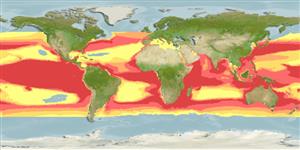Preferred temperature (Ref.
115969): 12 - 28.6, mean 24.8 (based on 5148 cells).
Phylogenetic diversity index (Ref.
82804): PD
50 = 1.0000 [Uniqueness, from 0.5 = low to 2.0 = high].
Bayesian length-weight: a=0.00646 (0.00265 - 0.01571), b=3.06 (2.86 - 3.26), in cm Total Length, based on LWR estimates for this (Sub)family-body shape (Ref.
93245).
Trophic level (Ref.
69278): 4.4 ±0.54 se; based on food items.
Resilienza (Ref.
120179): Molto basso, tempo minimo di raddoppiamento della popolazione più di 14 anni (K=0.18 (captivity); Fec=1-9 (could probably have 2 litters per year)).
Fishing Vulnerability (Ref.
59153): High vulnerability (63 of 100).
